Why your seedlings aren’t getting enough light
Light is the number one underestimated factor of growing, even at the seedling stage. If seedlings don’t have enough light, they grow more slowly and can become leggy. Overall, growers who do not give seedlings enough light have longer crop timelines and higher rates of seedling mortality.
Why do growers mistake the level of seedling light?
- They don’t have enough lighting.
- They place lighting too far from seedlings (bad coverage).
- They don’t leave lights on long enough.
Usually, these problems are easy to fix: add lights or adjust your seedling light schedules! Here are some general seedling light guidelines to speed up production and save you money on seeds.
How far away should I place seedling lights?
You’ve got to keep two goals in mind: the amount of light you’re giving seedlings, and the coverage of light that you’re giving seedlings.
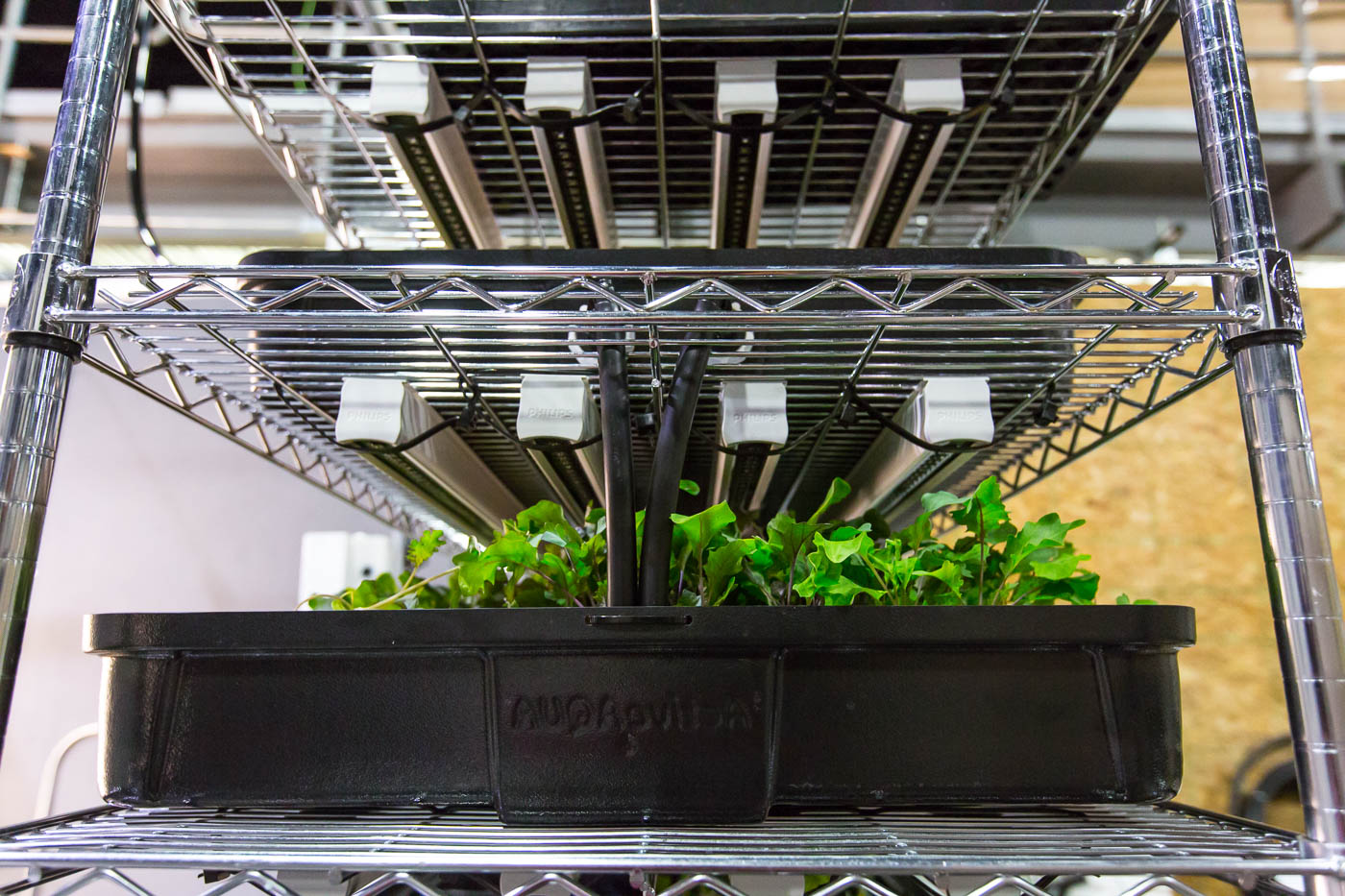
1) Amount of light:
We can measure the useful light to a plant (PAR—photosynthetically active radiation, or the parts of light that the plant can use to photosynthesize) in micromoles per meter squared per second (micromoles/sec/m²). The goal here is to deliver 120–150 micromoles/sec/m² of PAR to your seedlings.
Some people will use a PAR meter to figure out how much PAR they’re getting to their seedlings and will adjust the distance of their lights based on that measurement. Don’t worry—you don’t need one of those if you’re using LED bars or fluorescent bars. Just remember the following distances.
LED bars (like Phillips): 8–12 inches away from seedlings
T5 fluorescents: 5–6 inches away from seedlings

Read more: The Modern Farmer’s Guide to Indoor Lighting
2) Coverage of light
The next question is coverage. You can usually just eyeball this to figure out how far apart your lights need to be to deliver the same intensity of light across your entire seedling tray.
Again, we’ve outlined two simple rules to follow if you’re using the most common seedling lighting types:
LED bars: 8–10 inches apart from each other
T5 fluorescents: 4–5 inches apart from each other
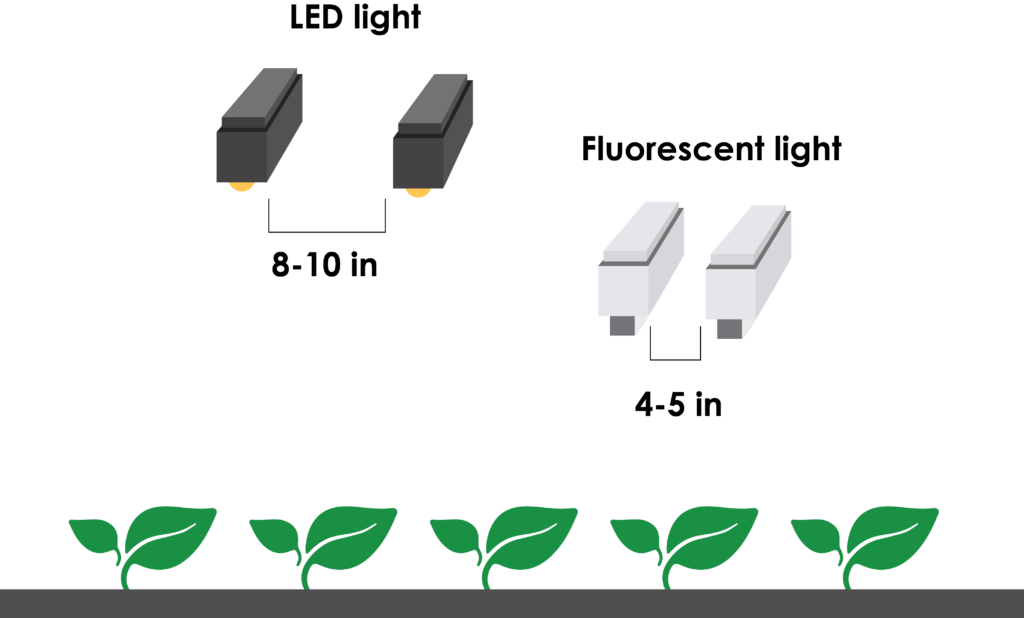
Stick to these rules, and your seedlings will be ready to transplant in no time.
How long should I keep lights on my seedlings?
One convenient thing about artificial lights is that you can set them to turn on and off by themselves using timers.
But how long should you keep light on your seedlings?
Balancing light and electricity costs
Growers are going to need 12–18 hours of light per day.
Your place in that range depends on the costs of two things: real estate and electricity. Which one is inherently higher for your facility?
This gives you four situations.
1) If the cost of real estate is higher, then you want to move things through your space quickly. This means that you will be paying for more hours of light (18 or so) to move crops along.
2) If the cost of electricity is higher but you have plenty of space, then you’ll want to reduce lighting a bit (12 or so hours). This means that your crops will grow slower.
3) If both costs are equally high like they are at our farm here in Laramie, then you’ll find a balance. We give our crops about 14 hours each day.
4) If both costs are equally low, then go ahead and run them fast, at about 18 hours a day. (Just remember to give crops everything else that they need as well, like airflow and CO2, or they won’t be able to use all that light.
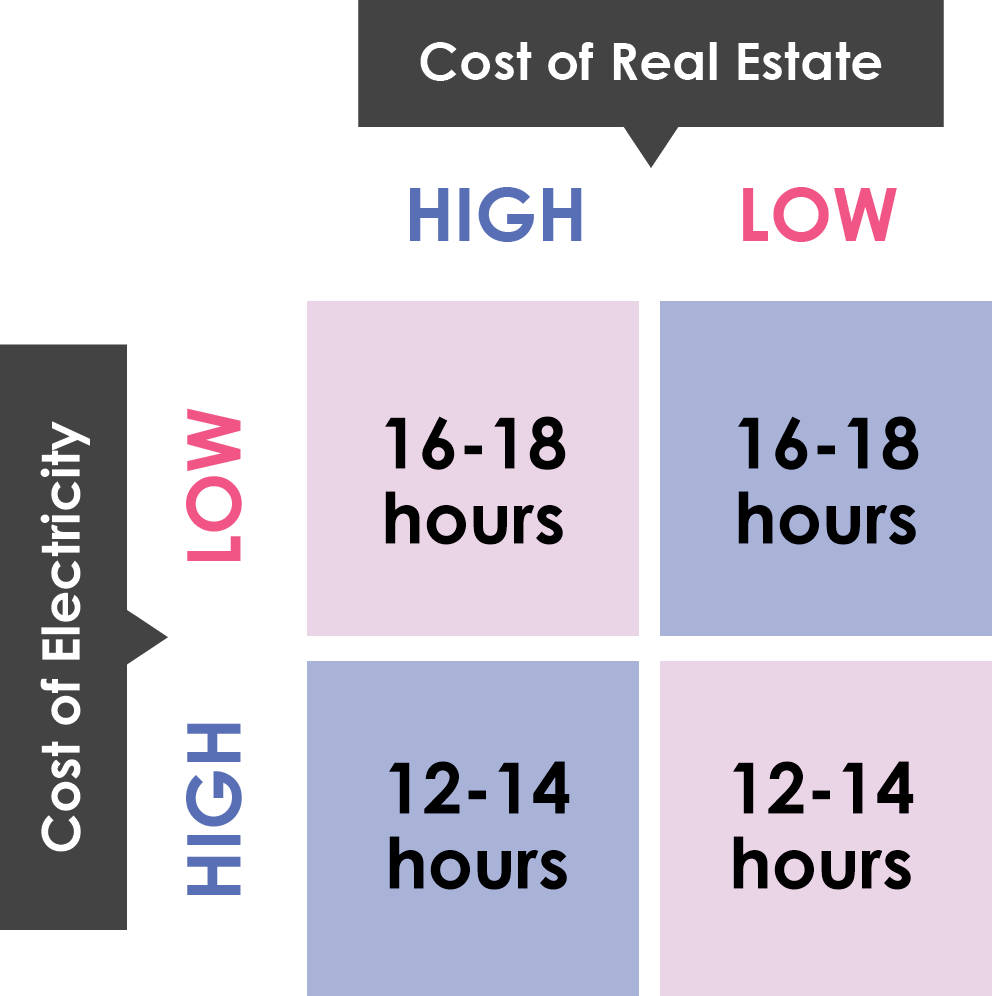
Don’t forget to harden your seedlings before transplant!
Remember to harden off your seedlings before transplanting them! Hardening seedlings involves hardening them to things like temperature and humidity, to reduce plant shock. It also means hardening them to light.
To harden your seedlings, place them in the main growing area for a few hours a day in increasing periods over about a week.
Need light help with the rest of your farm?
Light is one of the most important factors for growing healthy crops. Being a modern farmer like you comes with both a blessing and a curse: on one hand, light technology has never had so many quality options. On the other hand, choosing a lighting type can be a very overwhelming task.
To help you cut through the noise, we wrote The Modern Farmer’s Guide to Artificial Lighting. This guide explains the factors of a good light, how LEDs work, and some special considerations that indoor farmers may have for lighting.

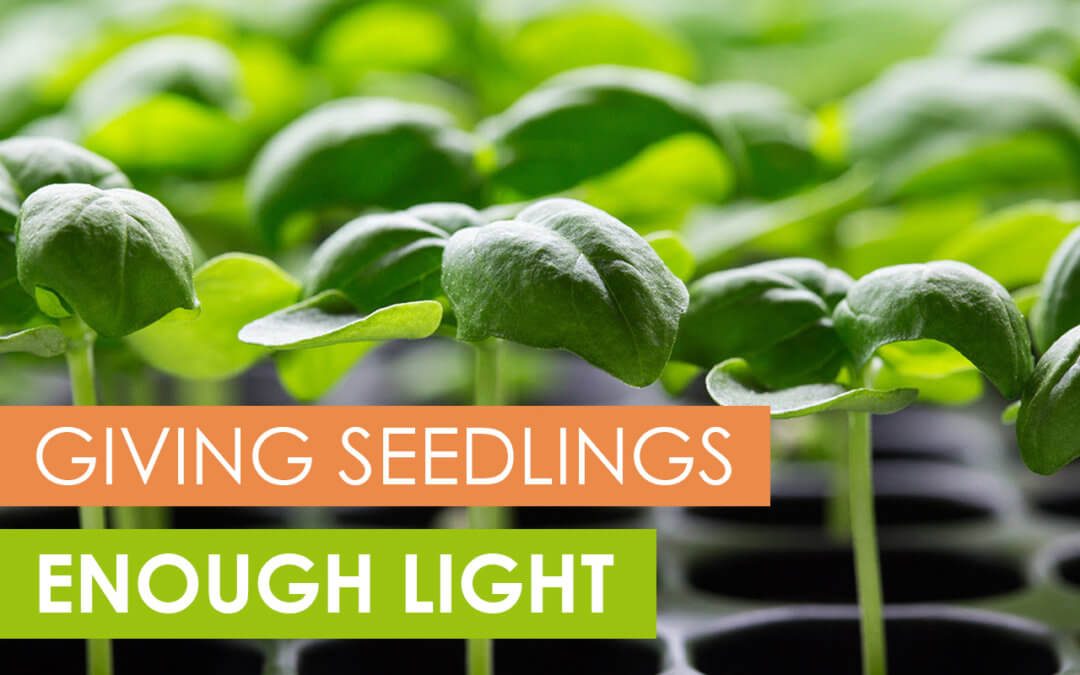
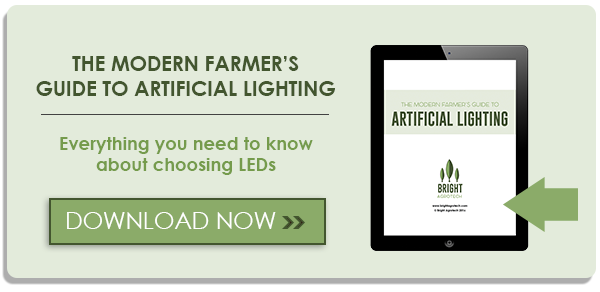

Hydroponics/Aquaponics is a massive global industry worth billions, but development countries the people who need it most are being left behind.
I am trying to develop Hydroponics/Aquaponics and Hydroponics fodder in Bangladesh conditions to make it cost effective with the participation of local farmer. Hydroponic/Aquaponics and fodder products is not popular in Bangladesh and competitive with ongoing agricultures ( not commercially viable option with seasonal crops). Bangladesh University of Agriculture, Maymanshing. Bangladesh Agriculture Research Institute trying for the same but so far to not so cost effective, not farmers friendly and not simplify to easy access for mass farmers (family farmer), rather it is replication of Westar system and Lab oriented.
Land to man ration in Bangladesh (2,497.4 per square mile), Water scarcity (seasonal), Land degradation with chemical fertilizer, pest infestation(Pesticides leading to health hazards for man and soil),unwise use of fresh water and degradation of ecosystem and rivers.
Vertical farming in urban environments has sprung out of a need to find alternatives to common practice in industrial agriculture. The way in which industrial agriculture is being conducted today has a wide spread negative impact on the environment as well as being economically inefficient in a number of ways.
Modern day agriculture is a major contributor to the large range of environmental problems the world is facing at present. Agricultural run-off, ecosystem degradation and loss, use of fossil fuel, food wastage, artificial irrigation and use of the world´s freshwater supply are but a few in a long list of issues that needs to be addressed if current agricultural practice is to be made truly sustainable in the future.
All the above will generate and making ground for hydroponics/Aquqaponics cultivation but, at a snail’s pace growing popularity of organic vegetable in urban areas. I am now trying to develop manpower and appropriate technology for our condition in cooperation (providing me lab and space) with Khulna University and also involving community for cultivation as do it yourself (DIY) approach. If I develop and standardized in Bangladesh condition then it must be a good productive agriculture system in water and land scar areas of Bangladesh, additional introduction of Aquaponics in urban city is a must to considering energy-water-environment- poverty- nexus of our country. The growth of urban population in Bangladesh is alarming compeer to any country of the world. Aquaponics is the highest productive food system would be cultivate in of season that’ are the beauty of the system (Farmers may get high price of vegetable) Aquaponis may go beyond season (which is my thrust area beside construction cost), for which it able to meet additional income of poor and future food security without impedes nature as water requirement (water footprint) is 95% less and productivity is 3 to 5 time higher and across seasonality that goes beyond existing agriculture and aquaculture practice, for which it would be good in coastal areas, where fresh water is scares. I am also trying to introduce Cow’s urine (Organic compost mater) in village grassroots small agriculture farmer with low-cost greenhouse.
Alone with urban Roof top- Aquaponics with which would improve health and sanitation in city environment and Aquaponics with Urine is the excellent high quality option for disable persons, house hold woman and children work with.
By 2050, we need to figure out how to not only feed but also nourish the three billion new people who will be joining the seven billion of us who are already here on the planet, and the year 2050, nearly 80% of the earth’s population will reside in urban centers. Applying the most conservative estimates to current demographic trends in Bangladesh is more adverse. And we need to figure out how to do this as effectively, ethically and as environmentally sensibly as possible.
Kindest regards
Rezaul Haq
wetlandbd@gmail.com
How are the red/blue diode color combinations better than white light?
Hi Jack, plant pigments absorb lights at very specific wavelengths. Chlorophyll a and Chlorophyll b, the two main photosynthesis pigments, absorb red and blue lights.
You can learn more about how plant use lights and different types of artificial lighting in this free eBook: http://info.brightagrotech.com/the-modern-farmers-guide-to-artificial-lighting
Hi,
I can’t open the link you posted. Page not found 🙁
Hey Nicola, sorry about that. Could you specify which link? I’ll get the correct one in there asap!
Great info here! Would you mind elaborating on the importance of hardening (first time I hear about it…), how much shock is there generally, and how does that affect operation / any tips?
One other thing I’m having trouble figuring out is how do you crunch the numbers on cost of real estate vs electricity then derive the number of hours of light?
Thank you very much!
Hey Edmund, sure. If the environment where you start a seedling and the environment where it is moved to mature are very different, then the plant might not have the necessary structure and defenses to deal with differences is temperature, airflow, light, etc. For instance, if a seedling is grown in a system that is sheltered and the air if very still, then it will not have the cues to grow a thick stem. If it is moved into a system with a lot of airflow (or outside where there is wind), its thin stem won’t be able to handle the change. Hardening a seedling is just breaking the transition from one environment to another into small steps so that the plant has the time to get ready for its new environment.
I am in the start up phase of setting up a vertical indoor micro green production facility and I am confused about the lighting systems that would work best for micro greens:
1. LED grow lights from Phillips (expensive)
2. T5 Florescents
3. T5 LEDs
From what I have read all 3 of them will work for micro greens, but which one is more cost-effective, t5 florescents or t5 LEDS. Any help with regards to this would be most welcome
Hey Atif – great question. At the seedling stage, plants typically only need 100-150 um/m2/sec. Fluorescents would provide plenty of light in this case. Just make sure that you have enough airflow to help with the heat!
I’m new at this. Starting veggies and flowers in my basement. I gave grow mats and 2 led light boxes. From reading I see the seeds need light for 12 to 18 hours a day. How about the heat mats. How long do they need to be on? Water daily? The one system I bought has self watering system.
Hi Suzanne,
Heat mats generally only need to be on until seeds have germinated. Daily watering is a good place to start. The media needs to stay damp during germination, but not waterlogged or soggy.
Hi
Is there danger of too much light? As in, if you have say 200 or 300 thousand micro moles? Just asking because because you seem to have a couple of 4′ tubes and I have a fixture that has 4 LED tubes. Am I in danger of providing too much light?
Hi Martin,
The light itself will not hurt them, however, there is the possibility that the lights can cause the plants to get too warm or to dry out.
UV light can bleach leaves even if a fan is blowing the heat away
similarly a 2800K 0r 3000k tube will not bleach the leave even if it gets them hot
Dont think that 6400-6500k is the answer depending of the manufacturer they can emit damaging amounts of UV to certain sensitive leaves like tomato . Toamtos do much better with red lightpedominating in teh mix in BOTH vegetative and bloom phase
5 week old tomato plantsthat had more red than blue grew twice as big as 5 week old tomato plants that had only cool white florescent. see thsi link for test data : http://www.nrcresearchpress.com/doi/pdf/10.4141/cjps65-089
BTW : P462 (top of page ) says “lights were raised 54” above the plants “
I germinate mine in a water base tray system from Frank’s seed, and use flood style 48 watt LED’s (red/blue,purple ) that mimic every wavelength of the suns rays, start 3-4 inches above tray lid until germinate then raise lights to ensure full exposure 6-8 inches above. In this system without heat mats seeds germinate starting at 36 hours to 10 days, by day 14 everything is between 2-4 inches tall. You can’t over or under water, no soil required it’s the perfect system
hey there ,i am a beginner micro green farmer,there is a lot of information and i am so confused ,please i need some tips about the germination time .. the seeds needs darkness at this stage?should i put the trays over each other ? i try this and when i am checking them after 2 days they were in disturbing mode,plenty of insects and moldiness . thank you
Hello wael,
The seeds don’t necessarily need darkness or light, depending on your varieties. By stacking the trays you limited the airflow over the seeds, which can cause the moldiness. Try keeping them open. Read this blog for more information on germination.
in the germination stage .does the seeds need watering every day?
wael—
You should water them a little bit in small increments throughout the day. Keep them moist, but avoid over-watering—there should be no standing water in the trays.
To help mitigate the problem, I raised the lights to eight inches, but within 24 hours, it was obvious that distance was still not enough. Through additional observation and research, I then raised the lights to 25” above the plants. However, light-bleaching was still an issue. I’ve continued to monitor plants and make adjustments.
At the time of this posting (day six under lights), I’ve disconnected one of the two lights, which is currently 20″ above the plants. I’m sure I’ll be going higher still as plants continue to get taller.
If you don’t have the budget for or interest in setting up a more advanced grow light system, remember that you can find success in the simplicity of a basic, 40-watt shop light. Rest assured that you won’t lose much regarding growth by using shop lights or any other full spectrum light.
Hi Lindsey,
The light-bleaching could also be the result of a deficiency. Double check your EC and pH levels to be sure they’re within the recommended ranges.
Hi
I’ve just set up my grow light frame and have my first tomato seedling emerge. My 45w Roleadro is currently at 20″ as this site has diagrams that suggest the PAR levels are around 150 at this hight.
https://www.greenbudguru.com/roleadro-45w-led-grow-light-panel-review/
(I’m not growing weed just tomatoes,peppers and cucumbers btw)
You mentioned having 8-12″ gap between the lights and plants. Is my light more powerful than the Phillips you mention or could the 20″ the diagram suggests be wrong?
Thanks 🙂
Hi Martin,
Lights are quite complicated and will vary quite a bit not only based on brand, but also by spectrum and intensity. These will also depend on what type of lights you’re using (e.g. LEDs vs HID vs fluorescent). It is entirely possible that the lights you are using are much different than the lights mentioned here—make sure you are seeing the results you desire, and if not, make adjustments as needed!
Thanks Mia
My plants were doing well but now some of them have leaves curling upwards and purple undersides?
I’m not sure if my lights are causing this but I’m pretty sure I’m not over/under watering.
I don’t want to move them higher up from the plants and them then grow leggy (if it’s not too much light causing it).
Do you know what the symptoms of too much light are? My understanding is I would be seeing white patches if they were getting burnt.
Thanks
Hi Martin,
Upward curl could be due to overwatering or high humidity. The purple color is often associated with phosphorus deficiency.
My grow frame is 25 inches wide by 53 long. I am having trouble choosing between a 6 bulb T5 HO fixture and an 8 bulb T5 HO fixture. Could you give me pros and cons on both?
Hi Alan—there aren’t really any pros or cons in regards to lighting differences, so it’ll just be a matter of sizing. You’ll also want to consider costs as well as configurations.
The article says 8″-12″ height for LED bars. What are the spec’s for these LED “bars”? What is the basis/logic for keeping LED “bars” higher than T5 fluorescents? I have LED shoplights that are 3000 lumens/4000K, what distance should these be from the top of germinated seedlings? If you have a shoplight so low (2″-8″) to the plants it doesn’t cover the whole width of a typical seedling tray. No one ever talks about the spread… how far does the light go to the sides from a typical bulb (LED & Fluorescent)?
Hello,
Is the light requirement in terms of PAR should remain constant throughout seedling phase? or it should be increased as the seedlings grows up until they are transplanted
Great, informative information. Thanks!
How would you compare Xenon Energy Saving Discharge Lighting (XED Lights) to LED and florescent?
I have started growing Strawbwrries. The plants flower and produce Strawberries In August this year, how do I get the plants to start flowering again? Hope you can help, I am in South Africa
Thanks a lot Amy for this terrific info about giving seedlings enough light. I must say that the content is well articulated and informative ,and yes! I will be coming back for more as I am looking forward to build my personal grow room. this ideas will be really helpful towards achieving my goal.
This article is a mix of good info and criminally false info. The light height and spacing so-called “rules of thumb” are particularly in error. Please do your research and edit the document.